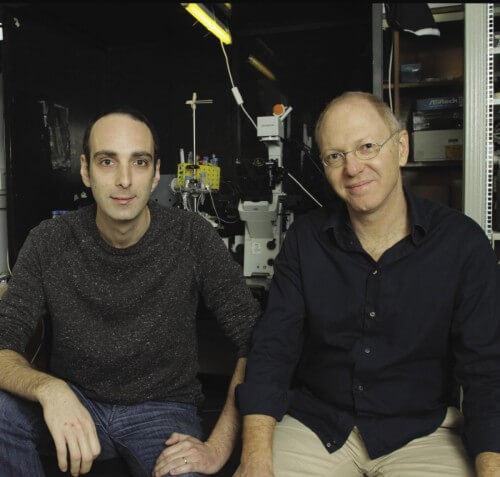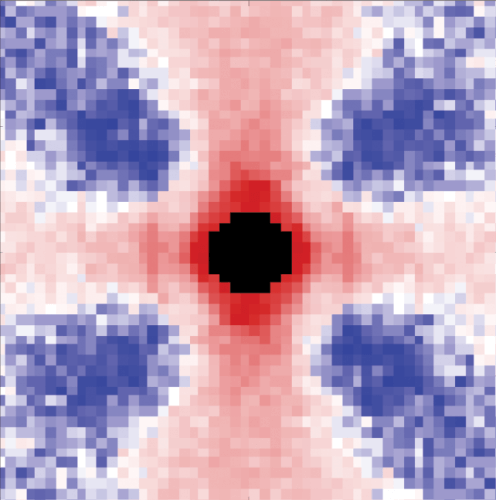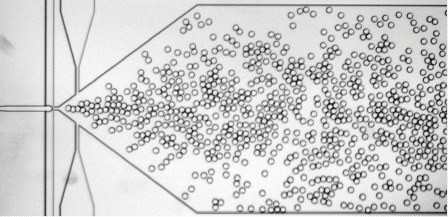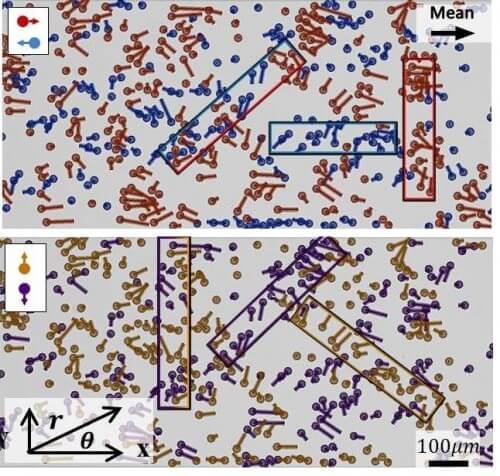The laws of traffic - a group of scientists from the Weizmann Institute of Science recently examined a similar chaotic system, and found a surprising hidden order that underlies it, and helps organize traffic on tiny and busy "roads".

Imagine a highway with 20 lanes, without any markings, signs, or speed limits. The result, needless to say, will be total chaos: the drivers will be forced, alternately, to zigzag, speed up and slow down - to adapt to the changes in the flow of cars. A group of scientists from the Weizmann Institute of Science recently examined a similar chaotic system, and found a surprising hidden order which is at its base, and which helps to organize the traffic on tiny and busy "roads". Their findings, recently published in the journal Nature Physics, may help reveal such organizing patterns in many types of chaotic systems, and yield new insights into the flow properties, which will benefit scientists working in the developing field of microfluids.
In complex systems, the importance of long-term interactions increases - mutual relations between all the individual partners, and therefore they tend to be unpredictable, and it is difficult to characterize and understand them. Several years ago, Prof. Roi Bar-Ziv, from the Department of Materials and Surfaces at the Institute, together with (then) research student Dr. Zvi Batos (now at Cornell University, New York), and the theoretical physicist Prof. Zvi Telusti (now at the Institute for Advanced Studies in Princeton) developed ), an experimental set-up where one can observe what happens to a particle present in such a system.

To simplify the system, the scientists made it two-dimensional: they started with a narrow channel - so narrow that the microscopic water droplets could only move in one line, one after the other. The water drops were carried in a stream of oil, but due to the friction exerted on them by the walls of the channel, they moved very slowly compared to the stream of oil - which is resistant to friction. The use of this simple, two-dimensional system allowed the team of scientists to observe phenomena whose complexity in research cannot be measured in three-dimensional systems, or even to measure them.
In the current study, the water drops moved in a wider channel (which is about half a millimeter wide and several centimeters long), so they were not limited to one line, but created complex two-dimensional movement patterns. Research student Itamar Shani, from Prof. Bar-Ziv's group, observed through a microscope the tiny droplets, which were pushed into the oil stream and moved chaotically. And yet, as the scientists discovered, beneath the chaotic flow, an organizing pattern could be discerned - a pattern that reveals a new type of "higher" order that organizes the behavior of particles in a dynamic system. In fact, the findings show how each of the particles involved in the system, which is seemingly independent of the others, is actually affected by each of the other particles.
Video: XNUMXD movement of water droplets in the oil stream
The organization in the system is reflected in the speed of movement of the drops and their direction - this was discovered when the scientists used specially developed computer programs, which are able to measure with high precision the speeds of many drops at the same time. When the drops were mapped and marked according to their relative speed - faster than average or slower than average - it was discovered, surprisingly, that there is a long-term correlation between their speeds.
The reason for the organized group behavior of the drops lies in friction: when the oil flows alone, only the friction with the channel walls affects its speed; However, when the oil stream meets water droplets, which are more sensitive to friction, some of its forward motion is transferred to the droplets. Whenever this phenomenon occurs, a "jump" appears in the oil flow profile. Any such disturbance to the flow changes the flow along the entire length of the channel, and therefore affects the movement of each of the other drops - to one degree or another.
The two-dimensional system for the flow of water droplets in an oil stream, created by the scientists
In order to understand the phenomenon better, Itamar Shani, Prof. Bar-Ziv, Dr. Batos and Prof. Telesti examined the interactions between pairs of drops: they looked for a correlation between their distance from each other and their relative speed. Indeed, the resulting graph showed an exact correlation - both positive and negative. The meaning of "positive" and "negative", in this case, is the degree of similarity in the speed at which the drops moved. A positive correlation - that is, pairs of adjacent drops that showed a coordinated speed (faster or slower than the average) - is found between drops that aligned vertically or parallel to the sides of the channel. A negative correlation - that is, pairs of drops, one of which is faster than the average and its partner is slower than the average - is usually far from the movement axis, along the diagonals.
In the continuation of the research, the team used a flow model based on their previous research, which they developed for the purpose of understanding the one-dimensional flow: they showed that the water droplets create flow patterns in the oil similar to the invisible lines of force that form around magnets: the flow of oil around each droplet splits and meets at two opposite points, secondary The Hebrews of the drop. Similar to what happens on both sides of a magnet, the "poles" in the current exert pushing or pulling forces on other drops. The team looked at the pairs again, this time theoretically, and calculated the mutual effects between pairs of droplets, using a two-body model based on just two droplets.

The two-dimensional system for the flow of water droplets in an oil stream, created by the scientists
The two-body model matched some of the observed speed correlations, but not all of them - and especially not the negative ones. The scientists found out that according to the model, the mutual relations cancel out too quickly with the increase in distance. They realized that the reason for the correlation in the speeds between the drops is not two-body, that is, it does not arise from the mutual relations between pairs of drops, but from their mutual relations with all the other drops. In light of this, the scientists added a third factor to the two-body model, which represents all the other droplets. Now, including only three factors, the theoretical model was able to describe the "higher" order that underlies the chaotic flow, based solely on simple mathematics and the locations of the droplets.
These findings may be relevant for any chaotic system in which there are long-term interactions, such as, for example, clusters of stars moving under the influence of the long-term force of gravity, or eddy currents. The observations and model may be particularly useful to scientists designing microsystems based on the flow of particles within flowing fluids.
Prof. Bar-Ziv says: "This research is unique in the field of multi-factorial systems in which large-scale forces operate, in that it presents an elegant, mathematically simple solution." In the future, the scientists plan to investigate how the system reacts to the changes caused in it, as well as to check whether it is possible to apply the guiding principles that were discovered for the purpose of mapping chaotic and turbulent systems.

